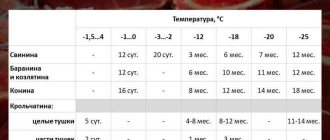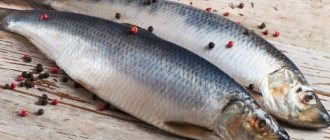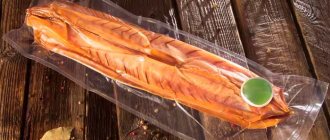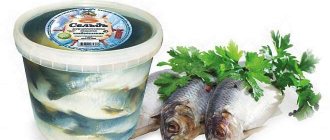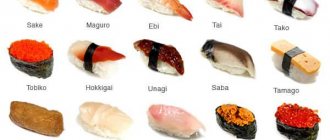Red salted fish is a valuable source of essential omega acids. This product gives beauty, youth, is useful for men, women, children, and the elderly. Previously, it was considered a delicacy. Nowadays it appears more and more often on our tables and is present in the daily diet. Therefore, every housewife should know the storage rules, expiration dates, and signs of spoilage.
Fish of the salmon family has a delicate taste and light aroma, so it is often used lightly salted. This option is most susceptible to damage. If there is insufficient salt in the product, bacteria actively develop and the risk of poisoning increases. Let's look at how to store salted red fish at home, how much and where it is better to do it, what kind of dishes and packaging to choose.
The benefits of salted red fish
Red fish is salted to maximize its shelf life.
The product is highly valued due to its large number of useful substances. Red fish contains vitamins B, D, E, calcium, phosphorus, magnesium, as well as healthy proteins, fats, carbohydrates and amino acids that are vital for the human body.
Doctors around the world advise including this product in your diet, and here's why:
- Fish oil strengthens the skeletal system and prevents rickets in children during cold periods, which occurs due to a lack of vitamin D.
- Fatty acids lower blood cholesterol levels, relieve stress on the cardiovascular system, and help cope with depression.
- Melatonin has a beneficial effect on sleep and helps cells recover.
- Vitamins strengthen the immune system, improve the digestive system and liver function, removing harmful substances and toxins from it.
- B6 helps with problems with the reproductive system, improves hormonal processes and fights infertility.
- E slows down the aging process and improves the condition of skin, hair and nails.
- Vitamin A normalizes the functioning of the visual system.
- B12 replenishes the lack of hemoglobin in the blood and improves blood circulation.
Salty fish
The most important indicators that determine the conditions and shelf life of salted and pickled fish are the concentration of table salt in the tissues of salted fish and acetic acid in the tissues of pickled fish. The higher these indicators, the more successful the storage of fish is.
Based on the degree of saturation of the fish with table salt, the finished product is divided into strong, medium and lightly salted.
The salt content in most heavily salted fish products is 14% or higher. Due to their high salinity, these products do not have a good taste, but they are produced industrially and are intended for long-term storage and transportation in unsatisfactory conditions.
Medium-salted fish usually contains 10-14% salt and has a better taste than heavily salted fish. It can be successfully stored at moderate temperatures if placed in good containers.
Lightly salted fish contains no more than 10% salt and has a good taste, tender meat, but is unstable in storage and requires especially careful packaging and storage at low temperatures.
The success of storage also depends on the quality of the container, methods of packaging salted fish, temperature and humidity in the warehouse.
Storing salted fish in barrels filled with brine is more successful than in dry barrels without brine. Brine well isolates fish from the external environment, reduces oxidative processes, and prevents the proliferation of aerobe bacteria. Brine should be protected from desalination, since desalinated brine sours and the product becomes moldy.
Salted fish reduces its quality when natural brine leaks out of the barrels or becomes moldy, and also if for some reason the brine had to be drained and the barrels topped up with artificial brine. Artificial brines cannot replace natural ones, which contain proteins, fat and extractive substances released from the fish during the salting process. In natural brines, fish acquires better taste, so the barrels must be strong so that the brine does not leak, and storage conditions must be optimal to prevent the brine from warming, freezing or desalination.
The relative air humidity in warehouses intended for storing salted fish in barrels filled with brine should be maintained at 90% or higher, since the risk of mold in this case is minimized. When air humidity drops below 90%, there is a danger of the upper rows of fish in barrels drying out, which is unacceptable for valuable goods, such as salted salmon. The storage temperature of salted fish should be in refrigerators from 0 to -5°, in glaciers 0-5°, in extreme cases 10°. Under these conditions, the shelf life of salted and pickled fish in the refrigerator is 8 - 12 months.
Defects in salted and pickled fish products can be divided into correctable (by appropriate cutting or additional processing) and irreparable.
Correctable defects include: dampness, duds, lop, improper cutting, mustiness, a coating of white spots, the initial stages of souring and damage by the jumper.
Dampness is the taste and smell of raw fish. This defect manifests itself especially noticeably on partly salted fish, the meat of which does not ripen. This defect is caused by ichor remaining in the gills of fish that are not sufficiently kept in brine. During subsequent processing of such fish by smoking, drying, and pickling, dampness is eliminated.
Mustiness - the smell of mold - is often found on salted shellless fish packed in boxes. By washing the fish and especially its gills in brine, this defect can be eliminated. Lopanets is a fish with a burst belly. This defect occurs when fish with a crowded digestive tract is salted. When cutting such herring into small fish, the defect can be eliminated.
Dud is the result of careless handling of fish. In some cases, such fish can be corrected by appropriate cutting.
Incorrectly cut fish, cut carelessly, without complying with the requirements of the standard. This defect can be corrected with appropriate additional cutting.
A coating of white spots can form on salted and pickled fish for many reasons and, above all, from the use of substandard salt for salting, containing a large amount of ballast salts, in particular calcium and magnesium salts. White spots of insoluble calcium lactic acid may form on marinated fish, as lactic acid tends to accumulate in marinades as a result of fermentation. In other cases, spicy and marinated fish may develop larger white spots consisting of amino acids (primarily tyrosine), which are products of protein hydrolysis.
Souring occurs due to improper storage. If fish is stored at high temperatures, the product may become moldy. In the initial stage of spoilage, cloudiness of the brine is detected. Gradually, the brine becomes viscous, viscous, and a sour smell appears, due to which this defect, despite the alkaline reaction of the brine, is called sourness in production. There is a deep breakdown of the hydrolysis products of proteins and other components of fish. It is recommended that at the first sign of a sour smell, replace the spoiled brine with a fresh saturated salt solution and take measures to quickly sell the goods.
Jumpers are the larvae of cheese flies that look like worms that move by jumping. Salted capless fish are affected by the jumper at elevated storage temperatures. In the initial stage of infection by the jumper, the goods are poured with strong brine, while the larvae float to the surface, they are collected and destroyed.
Incorrigible or difficult to correct defects include tanning, puffing, oxide, stalling, saponification, oxidation, and fuchsin.
Tanning is the initial stage of blood decomposition at the spine. Occurs when goods are stored improperly, for example when lightly salted herring is stored at elevated temperatures.
A puff—a putrid odor—appears in cases where the salting process was delayed and the fish meat began to deteriorate before the salt showed its preservative effect.
Oxide is the name given to rotting fish in practice when its meat becomes pale in color and begins to emit
unpleasant smell. This serious defect means that the fish is on the verge of permanent spoilage.
Welding is the loosening (up to complete disintegration) of the tissues of salted fish during abnormal heating, which can occur when storing goods near hot pipes, in the sun, etc. A batch of such fish should be repacked, separating the softened specimens, and filled with fresh saturated brine.
Saponification is a defect that is usually found on salted fish stored in boxes or barrels without brine. If a sudden warming of fish occurs, for example, when moving goods from a refrigerator to a warm warehouse or during transportation from northern to southern regions, dew appears on the surface of cold fish - a film of very weak brine in which bacteria quickly multiply. Gradually, the film becomes cloudy, viscous, similar to a layer of soap, with an unpleasant musty odor. At the beginning, this process can be stopped by washing the fish in a strong brine.
Oxidation (“rust”) is caused by the oxidation reactions of fat with oxygen in the air and appears as a yellow mark on non-ferrous goods stored at elevated temperatures. “Rust” also appears on salted fatty fish when stored in warehouses with high humidity (above 85-90%). The initial signs of “rust” are removable, but if it has penetrated into the thickness of the meat, then the product is unsuitable for food.
Fuchsin is an infection of fish by halophilic microorganisms. When warming unsalted fish products to 10°C or higher, halophilic microorganisms (salt lovers) can develop on them, which are found in all types of salt and, along with it, end up on the fish during salting. Fish meat affected by fuchsin first turns yellow under these films, then becomes slimy, loosens and acquires a sharp, unpleasant ammonia odor.
In terms of organoleptic quality indicators, salted fish must meet the requirements and standards given in the table.
Organoleptic signs of determining the freshness of salted fish
| Indicator name | Characteristics for the variety | |
| first | second | |
| 1 | 2 | 3 |
| Appearance | The surface of the fish is clean, the color characteristic of this species | |
| Fish with tight-fitting scales may have partially knocked-down scales; in fish with loose scales, the density is not standardized | Clustering of scales is not standardized | |
| Tarnished surfaces on silver pompano, cutlass, snapper, catfish, Pacific hake and silver hake; | ||
| tarnished surface; | ||
| slightly tarnished surface with a faint yellowish tint on the surface and cuts of heavily salted fish | ||
| Subcutaneous yellowing not associated with fat oxidation in seriolela, seriola, Australian salmon, bluefish, butterfish, bonito, wild boarfish, sabrefish, sei, Atlantic mackerel and ocean mackerel; subcutaneous coloration from golden to bright yellow in oceanic mullet; | ||
| yellowing of meat on cuts in cut mackerel and horse mackerel | yellowing on the surface, under the skin and cuts that has not penetrated into the meat | |
| The presence of dark spots (pigmentation) in Cuban crucian carp, Australian red snapper, redeye and other fish that have bright lifetime colors Reddening of the surface of horse mackerel Minor bruising in nototheniid fish Presence of eggs or milk at the anus of uncut Pacific hake Exit of part of the intestine through the anus without damaging the abdomen in wild boar fish | ||
| External damage | No external damage. Allowed in one packaging unit: broken gill covers - no more than 15% of fish; traces of binding; scales knocked down, | |
| head injuries | ||
| cracks, cuts, skin tears, slightly burst belly | ||
| without significant exposure of the insides - no more than 12% of fish | without loss of entrails - no more than 30% of fish | |
| Consistency lightly salted lightly salted medium salted | Tender juicy Same Dense juicy | |
| Strongly salty | Dense | |
| Slightly weakened is allowed | ||
| Taste and smell | Characteristic of salted fish, without foreign tastes and odors | |
| A slight odor of oxidized fat is acceptable | ||
How to choose
Here are a few rules for choosing salted or fresh fish for home salting:
- Decide in what form it will be more convenient for you to store it: by weight, cut into pieces or as fillets in vacuum packaging.
- After pressing on the fish, there should be no traces left on it. A quality product will be dense and elastic.
- If you buy pink salmon or salmon by weight, pay attention to the color. It should be light pink, without any spots or dark areas. A spoiled product will have a dark color, while a frozen product will have a light gray tint.
- If you buy salmon or trout steak, pay attention to the gray layer between the flesh and the skin. It should not be too thick, and the bones should fit tightly to the meat and not lag behind it.
- Fresh fillet has an even side cut.
- If the piece has a lot of white veins, it means that the part that is close to the tail was used. This part is drier, but the meat closer to the head part is tender and fattier.
- If you buy a product in vacuum packaging, make sure that there is no air or water droplets inside. If the packaging does not fit tightly to the product, this means that the storage and production technology was violated.
- Pay attention to the product label, which indicates the production date and expiration dates.
If you take these simple rules into account when purchasing and observe the shelf life of salted fish in the refrigerator, it will delight you with a fresh, unique taste.
Important. If a vacuum-packed product is stored in a store not in the refrigerator, but on a shelf, the risk of damage to the product is too high - do not buy such fish.
Signs of damaged goods
The most important condition when storing salted fish is to initially make sure it is fresh . After all, unscrupulous suppliers of goods strive to sell products whose shelf life expires in a couple of days. In order not to fall for their tricks, you need to know the distinctive features of stale salted fish:
- The color of salmon or pink salmon is too dark or, on the contrary, light. Fresh red fish should have a light pink hue.
- When you press the fillet with your finger, you will notice that it takes a long time to take its previous shape.
- The bones are easily separated from the fish.
- The skin of the fish is sticky or covered with an unknown mucus. This indicates the initial stage of bacterial reproduction.
- If a fish steak is sold in a vacuum package, it should not contain a drop of liquid, much less air bubbles.
- Too thick grayish layer between skin and meat.
- The expiration date is not clearly visible on the packaging or is completely erased.
These simple rules will help you choose a quality product. The main thing is to remember them in the store, not at home. After all, such a perishable product is almost impossible to exchange, much less return the money spent for it.
How to store red fish after salting at home
Salted fish is a perishable product. The storage location is chosen to be cold and dark. Check the fish every 2-3 days.
If you find signs of spoilage, do not eat it:
- Sticky coating on the skin. Rinse it off with brine and eat the fish immediately. The next day it will be irrevocably damaged.
- Loss of density and elasticity. Press the product with your finger: if the resulting dent does not straighten out, the fish has spoiled and should not be eaten.
Prepare for storage
If you have a large freezer, then you can take a batch of good fish and make preparations. Moreover, speaking about whether it is possible to freeze salted herring, it is worth noting that fresh it also fits well in the freezer. To do this, you need to wash it, remove the insides, dry it and pack it in plastic or foil. If you plan to cook something within two days, you can simply place it in the refrigerator. But make sure that foods, especially butter, are kept away.
If you want the herring to last for several months, then you need to place it in the freezer. To do this, the fish is gutted, washed and dried, and packaged in bags for freezing. You can do it differently. First, place the fish on a tray and turn on the “super freeze” function, and then put it into bags. It is stored for a very long time and at any time you can get fish ready for cooking.
Do you always follow the correct storage of food/medicines and their product proximity?
Yes, of course, this is very important so as not to spend money on your health later.
43.91%
Not really, because there won’t be anything like going to the toilet.
24.72%
I look at it by appearance and if I use anything after heat treatment.
31.37%
Votes: 271
Cold storage
Wrap the product in cotton cloth or paper, then immediately put it in the refrigerator. Store it at a temperature of +2...+4°C for no more than 5 days.
Soak a piece of cloth in table vinegar, wrap the fish, put it in a plastic bag and put it in the refrigerator. This way it will last no more than 10 days.
Another way is to leave the product in brine:
- lightly salted can be stored in the refrigerator for about 6 days;
- medium salted - 2 weeks;
- in a concentrated saline solution - a month.
If you are preparing a delicacy for a specific event, calculate the time in advance and choose a pickling method that allows it to be stored for the longest possible time.
Advice. Do not leave fish near other foods, especially eggs or vegetables. Bacteria form on them, which will lead to spoilage of the product if they lie nearby.
If the fish is purchased in a store in vacuum packaging, its shelf life is much longer:
- in the refrigerator at temperatures up to +6°C - 1 month;
- in the freezer at temperatures down to -8°C - 1.5 months.
After opening the vacuum packaging, consume the product within 24 hours.
Storage temperature
As noted above, it is recommended to store salted fish at a temperature not exceeding 10-12 degrees. Otherwise, its shelf life is several hours.
The optimal temperature is considered to be -8 degrees and below. In this case, if the packaging is used correctly, it is possible to maintain the freshness of the product for one and a half or even two months. A mandatory additional condition is the use of fresh and high-quality fish for salting.
Freezer storage
The freezer is the optimal place for long-term storage of red fish. To freeze salted salmon or trout, follow a few simple recommendations:
- Cut the fish into large pieces and pat them well with a paper towel or cloth. Rub until they are completely dry.
- Wrap the pieces in cling film, then place in a plastic bag.
- Remove excess air from the bag and seal tightly.
- Place the pieces in the freezer on one shelf. Then the odors will not mix during storage.
You can leave fish in the freezer for six months, but the sooner you take it out, the juicier, fresher and tastier it will be after defrosting.
Advice. Do not freeze salted fish with white meat (mackerel, herring). After defrosting, it loses its taste and density.
Thaw salted fish gradually. To begin, place the product from the freezer into the refrigerator for approximately 4 hours. Then it defrosts at room temperature. If you follow these rules, the fish will retain its structure, rich taste and color.
How to store it correctly
Salted fish is considered an ideal breeding ground for pathogenic microorganisms. That's why its proper storage is so important. Otherwise, health problems cannot be avoided. Below are the main ways to preserve product freshness:
- In a cellar, basement or any dark place . It is worth taking into account that the chosen room is not damp. The air temperature should not exceed ten degrees. The treat should not be stored in this form for more than 2-3 days.
- In the cold season, when the temperature outside the window does not exceed 5°C , it is allowed to leave salted fish for storage on the balcony for no longer than 3-4 days.
- It is best to store such a perishable product in the refrigerator . Here it can remain fresh and edible for up to 2 weeks . Experienced housewives store lightly salted trout and salmon in the following way - moisten a piece of cotton with six percent table vinegar and wrap the fish, previously cut into large pieces, in it. In this form, the product can be stored for up to a week. To increase shelf life, you should soak the fish in concentrated brine . Thus, salted pink salmon at home will be ready for consumption within 3 weeks. Finely chopped salted trout or salmon is stored in a jar with sunflower or olive oil. In this case, the shelf life will last up to a month .
- Salted fish can be stored in the freezer for up to 6 months . However, when choosing this storage method, it is worth considering that after defrosting, the products will lose some of the nutrients. This method is most often used for storing red fish: salmon, pink salmon, trout. Before freezing, it is recommended to completely clear the skin of scales and wrap it in cling film. Then place the fillet on a separate shelf in the freezer.
It is worth noting that for convenience, it is better to pre-cut the salted fish into small portions . This is necessary so that, if necessary, you do not have to defrost the entire carcass. After all, repeated freezing of the product is extremely undesirable.
You can also extend the shelf life of salted red fish using various spices: coriander, black peppercorns, bay leaf. All you need is to place the fragrant seasoning in the same package with the fish pulp.
Shelf life
If you want to preserve lightly salted salmon, salted trout, herring or mackerel for as long as possible, maintain the correct temperature.
In the refrigerator at a temperature of about +4°C:
- Medium-salted herring can be stored for no longer than 2 weeks;
- fatty mackerel - up to 10 days;
- lightly salted salmon - no longer than 3 days;
- lightly salted salmon in vacuum packaging - no more than 30 days;
- lightly salted fish of other types - up to 5 days;
- medium-salted and marinated seafood - no longer than 2 weeks.
If you follow these storage rules, the delicacy will delight you with its rich taste and delicate texture.
Note. If you have any doubts about the correct temperature conditions when storing salted fish, do not take risks. Seafood poisoning is dangerous to health. It’s better to play it safe and cook the salted fish again, observing the temperature conditions during storage.
Storing salted and lightly salted salmon
Salting salmon is the most common way to process it. Even a very large amount of salt cannot spoil it. This fish (like lard) absorbs only the required amount.
- You can store salted salmon on the refrigerator shelf in a container with brine, as well as on the loggia at +2°C (not higher).
- Lightly salted fish is kept refrigerated (possibly without brine).
Before storing salted salmon without refrigeration, it is peeled, divided into small parts, placed in a glass (ceramic) container, tightly closed with a plastic lid and wrapped in film. In such conditions, lightly salted salmon can be stored without refrigeration for up to 10 days.
General storage table
| Storage | Shelf life |
| At room temperature | no more than 5 hours |
| In a refrigerator | 7-10 days |
| In the freezer | 3-4 months |
How to salt red fish at home
Here's how to salt your own fish:
- Choose the right fish - trout, salmon, sockeye salmon, pink salmon or chum salmon are best.
- Open the abdominal cavity and gut it well, remove the head and cut off the tail and fins.
- Remove all scales and rinse the fish well in cold water.
- Make a cut along the ridge. Carefully separate it from the meat and remove all excess bones.
- Remove all films from the inside.
- Prepare 1 tbsp. l. sugar and 2 tbsp. l. salt per 1 kg of product.
- Mix salt and sugar together and season the fish well with this mixture.
- Place the fish in a deep bowl, skin side up, and cover tightly with a lid or cling film.
- Add your favorite seasonings or herbs if desired.
After some time, the pickling will begin to release juice. It will be ready in 2-3 days.
Advice. If you don’t want to bother with cutting up a whole fish, buy a ready-made fillet or piece right away. It will cost more, but will save a lot of time.
It will be ready in 10 hours, but it is better to leave it for 2-3 days - it will be salted better and will have a brighter taste. To finish the salting process, simply drain the water in which the fish was lying.
A few tips for the holiday table
A few tips for housewives on how to present this delicacy prepared with their own hands:
- Self-catering snack. Beautifully arrange thinly sliced pieces of red fish on a platter and garnish with herbs to taste.
- Filling for pancakes. Coat them with cream cheese on the inside, add pieces of fish, and add a little herbs to taste.
- Bruschetta with salted salmon. Fry slices of white bread in butter, place thinly sliced avocado and salmon slices on top.
Is it possible to freeze
Many housewives prefer to buy seafood at a promotional discount in the supermarket, and then store it in the freezer, that is, additionally freeze it. This option requires compliance with several mandatory rules:
- Only red varieties are suitable for freezing; they are preserved without loss of quality for 4-6 months.
- White varieties cannot be subject to additional freezing, since after defrosting they become watery and lose their taste.
- For storage, red varieties are cut into large pieces, dried with a towel, wrapped in cling film without access to air and put on the freezer shelf.
See also
The best way to store sewing threads, ideas for creating organizers and proven methods
Attention! Salted herring or mackerel should not be frozen!
Shelf life and storage conditions of fish according to sanitary standards
SanPiN 42-123-4117-86 contains information on the rules for storing particularly perishable products, which include fish.
The maximum period for its storage in raw form does not exceed 72 hours. A temperature regime of no higher than +6 degrees must be ensured. Higher temperatures provoke the active proliferation of bacteria that cause serious food poisoning.
Isothermal transport is used to transport products. If transportation is carried out in the summer, then it is necessary to ensure that the products are kept in ice. In such conditions, transportation within 3 hours is allowed. If there is no ice, delivery to the destination is carried out within one hour.
The raw storage temperature is within +2+6 degrees.
In rare cases, the storage period of a large batch that has arrived at the store is extended for a period of no more than 50% of the established storage period.
How to freeze salted herring
To do this, you will need to prepare a tasty brine and place the purchased fish in it for several days. Finished carcasses should be cut into pieces and placed in a food-grade plastic container. If you want to save some for eating, you can pour oil over the pieces and put them in the refrigerator compartment. In this form, it will last for 2-3 days.
Place all fish that you do not plan to eat in the near future in the freezer. Don’t listen to friends who doubt whether salted herring can be frozen. This method is not new at all. In Russia you can often find frozen, gutted, lightly salted herring on sale. It is harvested directly on ships after catching, by dry salting, and then dry-frozen. This fish is very tasty, but capricious in terms of storage; it does not tolerate re-freezing, so if you do not plan to eat it right away, put it in the freezer immediately.
